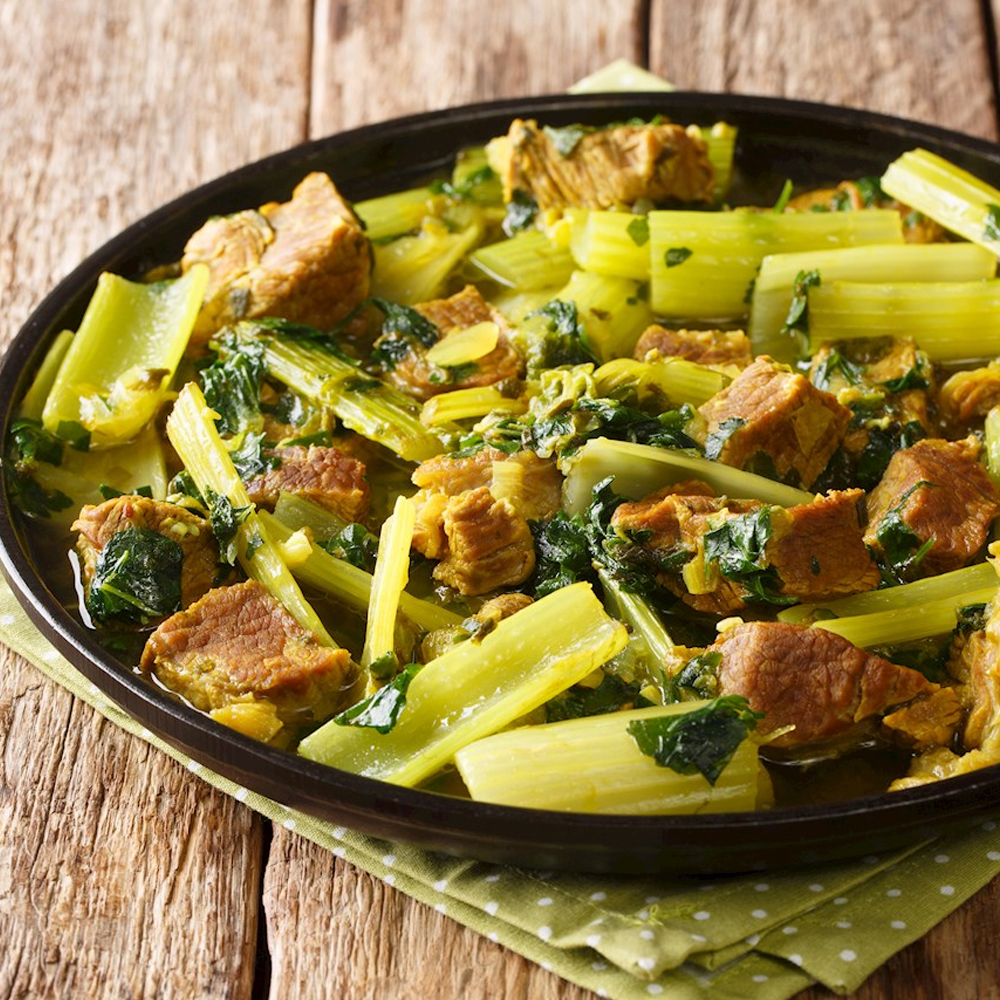Khoresh
Khoresh is a universal term which refers to a huge group of flavorful and versatile Iranian stews. Meat versions often incorporate poultry, lamb, or beef, but many use fish, vegetables, and lentils as the key ingredients. Regardless of the huge number of varieties, most Iranian stews are characterized by their thick consistency and incredibly flavorful sauces which typically include tomato paste, fresh herbs, or ground nuts.
They are always generously seasoned with a variety of spices and fresh herbs, and accompanied with saffron-infused rice.
Khoresh gheimeh
Khoresh gheimeh, occasionally called simply gheimeh or gheimeh polo, is a traditional Iranian meat stew made with yellow split beans. Traditionally it was always made with cubed beef or lamb, but modern variations sometimes include lean chicken breasts.
Unlike other traditional Iranian stews, the meat in gheimeh is usually cut into tiny cubes. Besides yellow split beans and meat, gheimeh often incorporates tomatoes and onions, all combined with traditional Iranian spices such as turmeric and dried lime.
Potatoes, spiced with saffron and fried separately, usually accompany the stew and are served on top of the dish. Steamed white rice or aromatic Persian rice, which is spiced with traditional Persian spice blends, is usually served alongside the dish. This thick and hearty stew with intense flavors is typically eaten as a nourishing lunch or dinner, and it is prepared throughout the year.
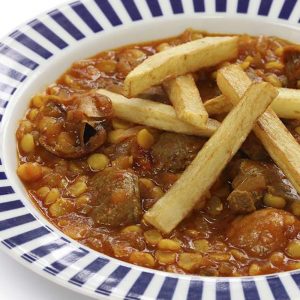
Ghormeh sabzi
Ghormeh sabzi is an Iranian herb stew, commonly eaten everywhere in Iran and considered to be the national dish of the country. Although there are numerous ways to prepare the dish, the essential ingredient is a combination of fried herbs, usually made with chopped parsley, cilantro, and chives.
Other varieties occasionally include greens such as leeks, kale, or spinach, which give the dish its dark green color and rich, pungent flavors. These essential ingredients are incorporated with kidney beans and cubed meat (most commonly lamb) to create a rich and dense stew.
The dish is traditionally served in a bowl and eaten with a knife and fork. Traditional Persian rice, known as polo, is usually served alongside ghormeh sabzi. The rice is boiled and steamed, resulting in an incredibly soft and mild side dish, and a perfect complement to this flavorful stew.
Even though it is considered a traditional Iranian dish, ghormeh sabzi is also commonly eaten in the neighboring Azerbaijan.
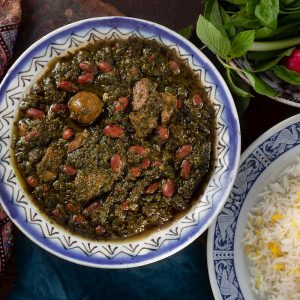
Khoresh bāmieh
Khoresh bāmieh is a traditional stew originating from Iran. The stew is usually made with a combination of beef or lamb, tomato paste, okra, onions, garlic, tomatoes, olive oil, turmeric, cinnamon, beef stock, bay leaves, salt, and peper. The meat is browned in oil and it’s then mixed with all the other ingredients except okra.
The pot is covered and the dish is simmered until the meat is tender. Near the end of cooking, okra is added to the pot and cooked until soft. The stew is served warm and it’s usually accompanied by rice on the side.
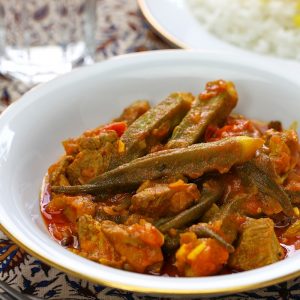
Khoresh karafs
Khoresh karafs is a traditional stew originating from Iran. The stew is usually made with a combination of celery, beef or lamb, onions, parsley, mint, garlic, lime juice, turmeric, oil, salt, and pepper. The onions and garlic are sautéed in oil, then mixed with the meat that’s browned and seasoned with turmeric, salt, and pepper.
The mixture is covered with water and simmered over medium heat. The celery, parsley, and mint are sautéed until soft, then added to the pot. The stew is simmered for a bit more until the meat is fully cooked, and lime juice is added to the pot near the end of cooking.
It’s recommended to serve khoresh karafs with rice on the side.
Khoresh alou esfenaj
Khoresh alou esfenaj is a traditional Iranian spinach and dried plum stew. It’s prepared with esfenaj (spinach), alou (prunes, especially the dried yellow variety known as alou bokhara), cubes of lamb or veal, onions, turmeric, lemon juice, saffron, cinnamon, and olive oil.
The stew is usually served in a deep serving bowl and it should be piping hot. It’s recommended to serve it with fluffy rice or a flatbread on the side.
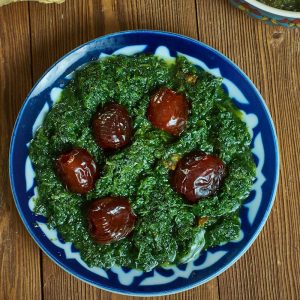
Khoresh havij
The star ingredients in this classic Iranian stew are julienned carrots that are simmered along with prunes, chunks of beef or lamb, and onions. The dish is usually seasoned with turmeric, saffron, lemon juice, and optionally cinnamon and cardamom.
This hearty carrot stew is traditionally accompanied by steamed rice (chelow).
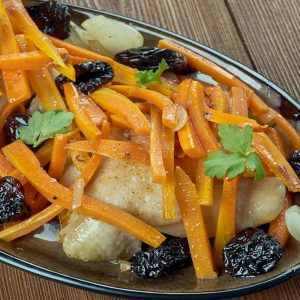
Korma-kari
Korma is a creamy meat stew (although it could also be made in a vegetarian version) with a mild flavor, made with saffron, yogurt, and various spices such as coriander, ginger, cumin seeds, chiles, and turmeric. It is believed that it originated in the royal kitchen of Akbar during the mid-1500s as a fusion of Persian and Indian cuisine.
The dish got its name after one of the tribes of the Rajputs, a warrior clan of western India. It is recommended to serve kormas with flatbreads such as chapati, paratha, or naan. There are three main bases of korma: North Indian korma with almonds, cashews and yogurt (there are two subgroups of this korma: Mughalai (with reduced milk) and Shahi (with cream)), korma Kashmir with almonds, cashews, yogurt, milk, and dried fruits, and South Indian korma with coconut, coconut milk, almonds, cayenne peppers, and fennel seeds.
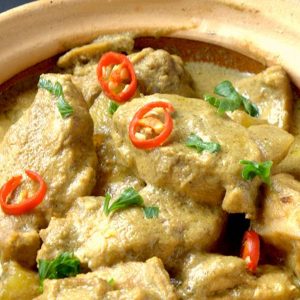
Khoresh kadu
Khoresh kadu is a traditional Iranian stew that combines meat and zucchinis. Most recipes call for lamb as the meat of choice, but it can be replaced with beef or chicken. There are also some versions of this dish that don’t include meat at all.
When preparing the stew, the meat is fried in vegetable oil with onions, garlic, tomatoes, and dried lime. The dish is seasoned with salt, pepper, and turmeric. Before they’re added to the stew, the zucchinis are usually gently fried. This thick stew is usually served with steamed Persian rice.

Khoresh kangar
Khoresh kangar is a traditional stew originating from Iran. The stew is usually made with a combination of acanthus (the tender white part of the plant’s stalks), onions, tomato paste, saffron, lime juice, turmeric, oil, salt, pepper, and meat such as beef, veal, lamb, or chicken.
The meat is browned in oil with sautéed onions, and it’s then seasoned with turmeric. The tomato paste is added to the pot, the mixture is seasoned with salt and pepper, and then simmered over medium heat until the meat is tender. The acanthus is fried and added to the pot with lime juice and saffron.
Once done, this stew is traditionally served warm with plain rice on the side.
Khoresh aloo
Khoresh aloo is a traditional stew originating from Iran. This savory-sweet stew is usually made with a combination of prunes, lamb or chicken, saffron, sugar, carrots, potatoes, onions, turmeric, salt, pepper, and oil. The onions and meat are sautéed in oil, seasoned with turmeric and pepper, and simmered in water until tender.
The saffron and prunes are added to the pot with salt and sugar, followed by the carrots and potatoes that have been boiled and fried in oil. When the consistency of the stew reaches the desired point, it’s typically served warm with rice on the side.
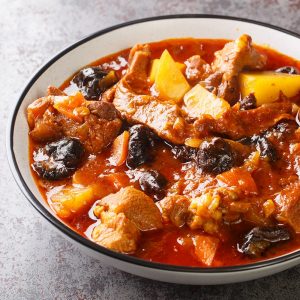
Khoresh lubia sabz
Khoresh lubia sabz is a traditional stew originating from Iran. The stew is usually made with a combination of green beans, chicken or lamb, onions, garlic, tomatoes, cumin, cinnamon, turmeric, red pepper flakes, lime juice, oil, salt, and pepper.
The onions and garlic are sautéed in oil, then mixed with the meat that’s seasoned with turmeric, salt, pepper, cumin, and red pepper flakes. The tomatoes are added to the pan and the mixture is covered with water and simmered over low heat.
The green beans are sautéed and added to the pot with cinnamon and lime juice. The stew is cooked for a bit more until the sauce becomes thick and the meat and green beans become tender. Khoresh lubia sabz is traditionally served with rice on the side.
Khoresh rivas
Khoresh rivas is a traditional stew originating from Iran. The stew is usually made with a combination of rhubarb, mint, parsley, turmeric, onions, salt, pepper, oil, and stewing meat such as lamb, chicken, or beef. The onions are sautéed in oil, seasoned with turmeric, and mixed with the pieces of meat that are browned and seasoned with salt and pepper.
The mixture is covered with water and simmered over low heat. The herbs are sautéed and added to the pot with the rhubarb and the stew is simmered for a bit more until everything is nice and tender. Khoresh rivas is traditionally served over steamed rice.
Khoresh bādemjān
Khoresh bādemjān is a traditional stew originating from Iran. The stew is usually made with a combination of eggplants, tomatoes, tomato paste, sour grapes or lime juice, onions, garlic, turmeric, saffron, oil, salt, pepper, and stewing meat such as lamb or beef.
The meat is cooked in water and seasoned with turmeric, salt, and pepper. The eggplants are sautéed in oil with the onions before the tomato paste, garlic, and saffron are added to the pot. The cooked beef, tomatoes, eggplants, and sour grapes or lime juice are added to the stew and it is then simmered over low heat until everything is nice and tender.
This stew is traditionally served over Persian steamed rice.
Fesenjān
Khoresh fesenjān (or just fesenjān) is a popular Iranian pomegranate and walnut stew. It is usually made with chicken which is served submerged in a thick, dark sauce made with ground walnuts and pomegranate syrup. Usually prepared and eaten on special occasions, it is a staple dish of the annual festivity celebrating the winter solstice.
The dish is typically served alongside plain white rice or naan bread, and it is occasionally garnished with pomegranate seeds. Fesenjān is a dish commonly found in the Middle East region, especially in the neighboring Azerbaijan and Iraq.
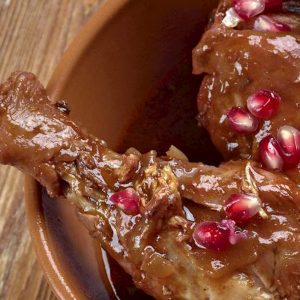
Anar bij
Anar bij is a traditional Iranian stew originating from Gilan. It is made with a combination of ground meat (usually meatballs), onions, turmeric, pomegranate paste, ground walnuts, and various herbs such as parsley and fenugreek. During the cooking process, this stew develops a sour flavor.
Anar bij is traditionally prepared and served for special occasions and celebrations.
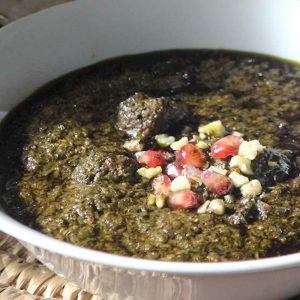
Baghali ghatogh
Baghali ghatogh is a traditional dish originating from northern Iran. The dish is usually made with a combination of lima beans, dill, eggs, butter, turmeric, garlic, saffron, salt, and pepper. The turmeric and garlic are cooked in butter until fragrant, and then mixed with dill, cooked beans, crushed saffron, and water.
The mixture is simmered over medium heat until the beans become tender. The dish is seasoned with salt and pepper, and then a few shallow wells are formed with a spoon in the bean mixture. An egg is cracked into each well, and baghali ghatogh is cooked until the eggs set.
Before serving, the dish is sprinkled with saffron, and it’s recommended to pair it with rice or bread on the side.
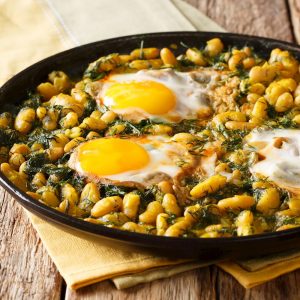
Khoresht-e-chaghartameh
haghartameh is a traditional Iranian stew originating from Gilan. The dish is usually made with a combination of chicken, onions, eggs, tomato paste, flour, salt, pepper, oil, turmeric, verjuice, and cinnamon. The chicken pieces are cooked in water with fried onions, turmeric, salt, and pepper.
The bones are then removed, and the meat is cut into pieces before it’s fried in a mixture of oil, turmeric, seasonings, tomato paste, cinnamon, and the leftover chicken broth. Verjuice is added to the sauce, along with a few beaten eggs, and the dish is simmered for a few minutes before serving.
It’s recommended to garnish the stew with fried onions and serve it with rice.
https://www.tasteatlas.com/

